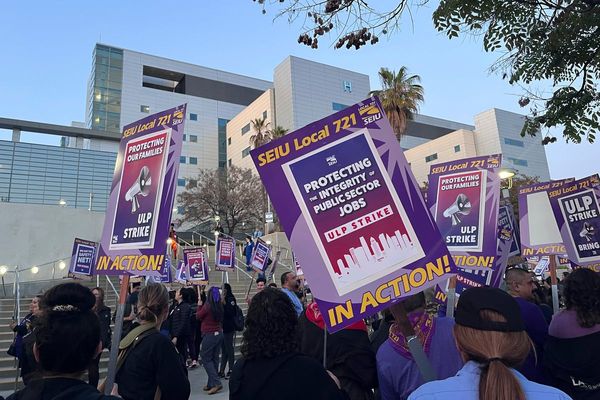Israeli strikes across the southern Gaza Strip killed at least 26 overnight into Sunday, including a senior Hamas political leader and several women and children, according to the militant group-run health authorities.
Gaza's health ministry said the total number of Palestinians killed in the Strip since the start of the Israel-Hamas war has now passed 50,000 after Israel ended the ceasefire last week with a wave of strikes that killed hundreds, reaching a total of 50,021.
The latest toll announced on Sunday includes 673 people killed since Israel's surprise bombardment on Tuesday, as well as 233 bodies that were recently identified, the ministry said.
The Hamas-run ministry does not differentiate between combatant and civilian casualties. Israel says it has killed around 20,000 fighters, without providing evidence.
Meanwhile, Israel has continued striking what it says are militant targets and has launched ground incursions in northern Gaza.
Late on Saturday, Israel's cabinet approved a proposal to set up a new directorate tasked with advancing the “voluntary departure" of Palestinians in line with US President Donald Trump's proposal to depopulate Gaza and rebuild it for others.
Israeli Defence Minister Israel Katz said the new body would be “subject to Israeli and international law” and coordinate "passage by land, sea and air to the destination countries.”
Palestinians in Gaza have stated they do not want to leave the Strip, and rights groups have said the plan could amount to expulsion in violation of international law.
‘Displacement under fire’
Meanwhile, the Israeli military ordered civillians to leave Rafah’s already heavily destroyed Tel al-Sultan neighbourhood on foot along a single route to Muwasi, a sprawling area of tent camps. It later announced that troops had encircled Tel al-Sultan to eliminate Hamas fighters and militant infrastructure.
“It’s displacement under fire,” said Mustafa Gaber, a local journalist who left Tel al-Sultan with his family. In a video call, he said hundreds of people were fleeing as tank and drone fire echoed nearby. “There are wounded people among us. The situation is very difficult,” he said.
Mohammed Abu Taha, another resident who fled, said many people were unable to evacuate because of the surprise incursion overnight. He also said his sister and her family were sheltering in a school in an area of Rafah surrounded by Israeli forces.
The Palestinian Red Crescent emergency service said it lost contact with a team of medics who were responding to strikes in Rafah. Spokeswoman Nebal Farsakh said the last communication was at 7:15 am local time (6:15 am CET) and that some of the medics were wounded.
There was no immediate comment from the military, which says it only targets militants and tries to avoid harming civilians. Israel has held Hamas responsible for civilian deaths because it operates in densely populated areas.
IDF strike kills Hamas leader as Houthis resume attacks on Israel
Hamas said that Salah Bardawil, a well-known member of its political bureau, was killed in a strike in Muwasi.
Hospitals in southern Gaza said they had received another 24 bodies from strikes overnight, including several women and children.
The European Hospital said five children and their parents were killed in a strike on the southern city of Khan Younis. Another family — two girls and their parents — were killed in a separate strike.
The Nasser Hospital in Khan Younis said it received the bodies of two children and their parents who were killed in a strike on their home. Two other children are still under the rubble, according to the hospital.
The ceasefire that took hold in January paused more than a year of heavy fighting ignited by Hamas' 7 October 2023 attack on southern Israel, in which its militants killed some 1,200 people, mostly civilians, and took 251 hostage. Most of the captives have been released in ceasefire agreements or other deals.
In the first phase of the latest ceasefire, 25 Israeli hostages and the bodies of eight others were released in exchange for hundreds of Palestinian prisoners. Israeli forces pulled back, allowing hundreds of thousands of people to return to what remained of their homes, and there was a surge in humanitarian aid.
The sides were supposed to begin negotiations in early February on the next phase of the truce, in which Hamas was to release the remaining 59 hostages — 35 of whom are believed to be dead — in exchange for more Palestinian prisoners, a lasting ceasefire and an Israeli withdrawal.
Those talks never began, and Israel backed out of the ceasefire agreement after Hamas refused Israeli and US-backed proposals to release more hostages ahead of any talks on a lasting truce.
In a separate development, Iran-backed Houthi rebels in Yemen, who are allied with Hamas, launched another missile at Israel overnight and into Sunday, setting off air raid sirens. The Israeli military said the projectile was intercepted, and there were no reports of casualties or damage.
The Houthis resumed their attacks on Israel after it ended the ceasefire, portraying them as an act of solidarity with the Palestinians. Trump ordered the renewal of US strikes on the group last week over its previous attacks on international shipping in the Red Sea.
The rebels have said they are trying to blockade Israel, but most of the ships they have targeted have no connection to the conflict.







